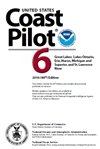| Back to Back Issues Page |
 |
|
Rhumb Line, Vol 4 Issue 3 -- New at www.great-lakes-sailing.com December 06, 2016 |
Rhumb Linea course that keeps a constant bearing
The Rhumb Line for Great Lakes Sailing is clear: to provide a comprehensive listing of ports around the Great Lakes basin and articles that cover a broad range of topics of interest to sailors. The purpose of Rhumb Line is to keep you up-to-date with new additions to Great Lakes Sailing and articles of interest in a brief, easy-to-scan and concise manner. I value not only your interest but also your time. 1. New Ports 2. Proximity Alarms on a Chartplotter or GPS 3. Using the US Coast Pilot / Canadian Sailing Directions 4. Things Your Spouse/Partner Should Know 5. Toronto International Boat Show Schedule 6. The Romance of the Sea – Traditions, Customs and Sayings 1. New Ports (a) Beardrop Harbour, ON 2. Proximity Alarms on a Chartplotter or GPS Most, if not all, chartplotter or GPS units have a 'proximity' alert – a beep when you come within a pre-set distance of a waypoint. In all likelihood, that 'beep' is also distinct from other beeps or alarms that your unit will sound. Here are some ideas on how to use this feature. 1) Approach a Waypoint The most obvious use is to give advance notice that a waypoint is being approached A pre-set alarm set for 1 nautical mile can give you sufficient time to plan a course alteration. Depending on the configuration of your unit, pull up the "proximity" menu or select the relevant waypoint. This allows you to select any waypoint, increase the distance of the alarm, and toggle the alarm. Your proximity alarm most likely has a distinct series of beeps to distinguish it from other alarms. 2) Turn Onto a New Course If you have a critical course alteration coming up that will require something more than simply moving the wheel/tiller 15° or 20°, a proximity alarm can give you sufficient time to plan the execution of a heading change, falling off, tacking, or jibing. The advance notice can give you time to trim your sails for the new course, warn/prepare crew, do a careful sweep of the surrounding waters, switch from auto pilot to manual steering, etc. 3) Approaching Landfall Approaching landfall can bring mixed emotions. There is the pleasure and anticipation of reaching a destination port or anchorage. However, there can also be the apprehension of making that final approach. For safety (and less apprehension and thus more enjoyment), you want to have time to prepare for landfall. If you set a proximity alarm 3-5 nm out (or the equivalent to 30-60 minutes, depending on your boat and speed), you will have time to plan an approach, carefully scan surrounding waters for traffic or hazards, prepare lines or ground tackle and most importantly, go over your approach with your crew. 4) Using Contour Curves. Navigation charts show depths as regularly spaced 'contours lines'. These lines connect similar depths on the bottom and are shown in feet, meters or fathoms (Look on your chart for the units! - check the large magenta letters at the top right corner of the chart.) If you program the proximity alarm to sound when you cross specific contour curve, it can serve as a back up to your navigation planning. 5) Danger Alert If there is a hazard or obstruction that you need to avoid (rock awash, sand bar or reef), determine the closest safe distance to pass it. Calculate the latitude and longitude of the danger point's closest position to your course. Enter this as a waypoint. Determine how close you want to approach this danger point and then set a proximity alarm. 6) Dragging Anchor Naturally, a proximity alarm can work well to alert you to a dragging anchor. Draw a circle around your anchored position that takes into account swing and some small amount of drag. Set the proximity alarm to sound when the boat touches the edge of the circle. 3. Using the US Coast Pilot / Canadian Sailing Directions Both Canada and the United States publish a document called a Coast Pilot (US) or Sailing Directions (Canada). These guides are companions to charts. They provide a wealth of additional information that is usually not shown on navigation charts.  U.S. government policy is that as this information was paid for by the taxpayers, it is therefore available to citizens at no charge. Canadian government policy is that the information is paid for by taxpayers but then transferred to a private firm that resells them to bookstores and chandleries. That way, citizens get to pay to see what they have already paid for. (Links for these are available in the Free
Resources
section of the website.)
U.S. government policy is that as this information was paid for by the taxpayers, it is therefore available to citizens at no charge. Canadian government policy is that the information is paid for by taxpayers but then transferred to a private firm that resells them to bookstores and chandleries. That way, citizens get to pay to see what they have already paid for. (Links for these are available in the Free
Resources
section of the website.)Using a Coast Pilot or Sailing Directions in conjunction with your chart can add greatly to your planning process. Using small coloured tabs or flags, you can mark the relevant pages for quick access. You can also use those coloured flags to indicate on your chart the location of these additional features such as landmarks, prominent features, dangerous rock or shoals and points of interest. Using this additional useful information found in the US Coast Pilots or Canadian Sailing Directions will only increase your navigation skills and local knowledge. This in turn makes your sailing safer and much more enjoyable. 4. Things Your Spouse/Partner Should Know While this is not always the case, many times when a couple are sailing, the reality is that it is being single-handed with a passenger on board. Male or female, there are many cases where one partner is the primary person with the keen interest and the skill set to run the boat. So, the question becomes, have you worked out a plan to to train your spouse or partner in what they need to know to operate your boat? In an emergency or if you are incapacitated, it's vital that they could run things alone. Boating author John Vigor his terrific book The Seaworthy Offshore Sailboat has assembled a list of must-knows that I have reproduced here. They bear thinking about. 1) Marine anchor and ground tackle 5. Toronto International Boat Show Speaking Schedule The Toronto International Boat Show is the largest indoor boat show in North America. It is certainly the place to be if you love sailing. There is enough kit available to test the limits any credit card!  The show runs from January 20th to 29th, 2017. Weekday hours are 1100 to 2000, Saturdays 1000 to 1900 and Sundays 1000 to 1800.
The show runs from January 20th to 29th, 2017. Weekday hours are 1100 to 2000, Saturdays 1000 to 1900 and Sundays 1000 to 1800.As in previous years I will be speaking at the Show about getting out and exploring the Great Lakes. My speaking schedule is as follows: Sat. Jan 21st @ 10:30am (Salon 107) Mon. Jan 23rd @ 3:30pm (Salon 107) Wed. Jan 25th @ 2:30pm (Salon 107) Thurs. Jan 26th @ 6:30pm (Salon 107) Sat. Jan 28th @ 12:00m (Presentation Theatre) Sun. Jan 29th @ 3:30pm (Salon 107) If you are at the show, drop by and say 'hello'. I would love to meet you. 6. The Romance of the Sea – Traditions, Customs and Sayings One of the things that I have always enjoyed about sailing is how so much of what we say and do today is bound up in the customs and traditions of long ago. Aloof comes from the old Dutch word loef meaning 'windward'. By the late 16th century, it was being used by English sailors as well. It describes a ship sailing along a lee shore with her head pointing high into the wind to prevent her being driven ashore. It also described a sailing ship in a fleet with her sails set higher so that she drew away from the fleet. Not hard to see how it arrived at its present meaning to describe someone who stands apart Black Book refers to the Admiralty Black Book. Dating back to the 14th century, it details expectations about ship conduct and discipline in the Royal Navy. The Black Book was based on the Thanks for reading Rhumb Line. Your opinions, thoughts and comments do matter. If you have any comments or questions, please feel free to contact me here at Rhumb Line or at Great Lakes Sailing. If you like this newsletter, please do a friend and me a big favour and "pay it forward." If a friend DID forward this to you and if you like what you read, please subscribe. You will find a subscribe button on most pages of the site. |
| Back to Back Issues Page |